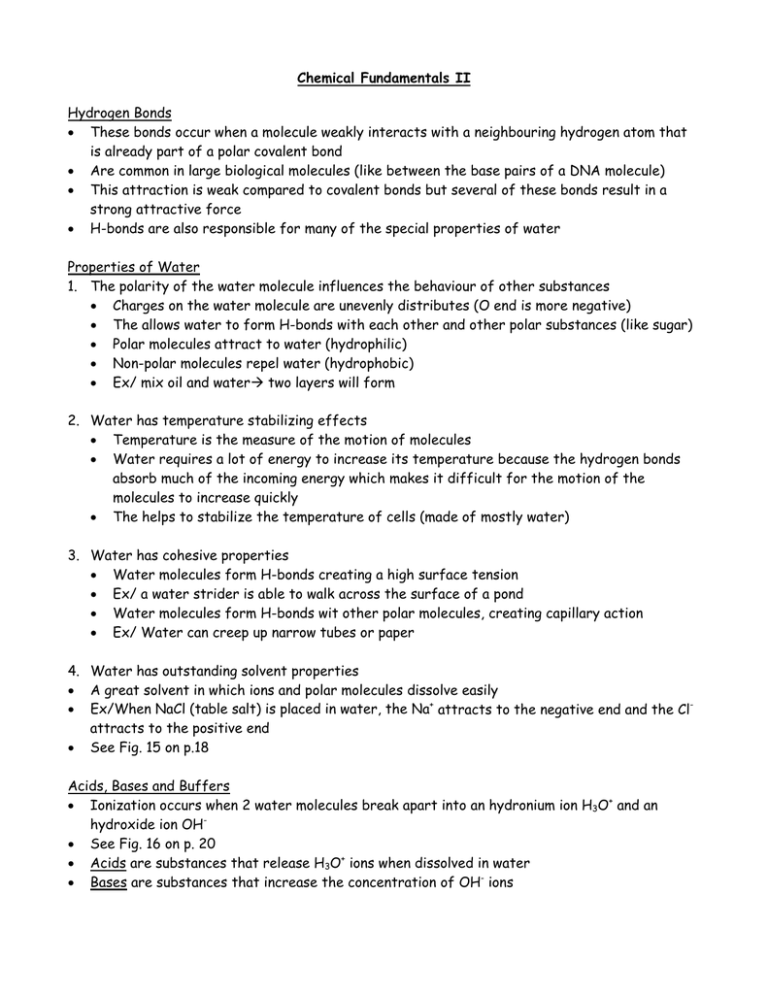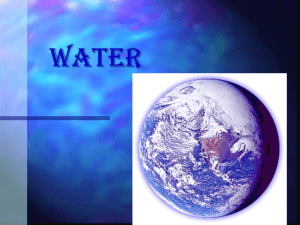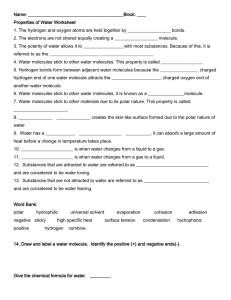Chemical Fundamentals II Hydrogen Bonds
advertisement

Chemical Fundamentals II Hydrogen Bonds These bonds occur when a molecule weakly interacts with a neighbouring hydrogen atom that is already part of a polar covalent bond Are common in large biological molecules (like between the base pairs of a DNA molecule) This attraction is weak compared to covalent bonds but several of these bonds result in a strong attractive force H-bonds are also responsible for many of the special properties of water Properties of Water 1. The polarity of the water molecule influences the behaviour of other substances Charges on the water molecule are unevenly distributes (O end is more negative) The allows water to form H-bonds with each other and other polar substances (like sugar) Polar molecules attract to water (hydrophilic) Non-polar molecules repel water (hydrophobic) Ex/ mix oil and water two layers will form 2. Water has temperature stabilizing effects Temperature is the measure of the motion of molecules Water requires a lot of energy to increase its temperature because the hydrogen bonds absorb much of the incoming energy which makes it difficult for the motion of the molecules to increase quickly The helps to stabilize the temperature of cells (made of mostly water) 3. Water has cohesive properties Water molecules form H-bonds creating a high surface tension Ex/ a water strider is able to walk across the surface of a pond Water molecules form H-bonds wit other polar molecules, creating capillary action Ex/ Water can creep up narrow tubes or paper 4. Water has outstanding solvent properties A great solvent in which ions and polar molecules dissolve easily Ex/When NaCl (table salt) is placed in water, the Na+ attracts to the negative end and the Clattracts to the positive end See Fig. 15 on p.18 Acids, Bases and Buffers Ionization occurs when 2 water molecules break apart into an hydronium ion H3O+ and an hydroxide ion OH See Fig. 16 on p. 20 Acids are substances that release H3O+ ions when dissolved in water Bases are substances that increase the concentration of OH- ions When an acid combines with a base, they undergo a neutralization reaction, which produces a salt HCl + hydrochloric acid NaOH sodium hydroxide NaCl sodium chloride + H2O water The pH scale, is used to measure the concentration of H3O+ in aqueous solutions pH = -log10 [H3O+] Buffers are molecule that can combine with hydrogen ions, release them, or both, thereby stabilizing the pH Ex/ bicarbonate in the blood helps to restore pH when the blood is too acidic See Fig. 18 on p.22 Buffers help to counter small shifts in the pH of the internal fluid environment that sustains all the cells Homework: p.23 #8-11, 13-16







